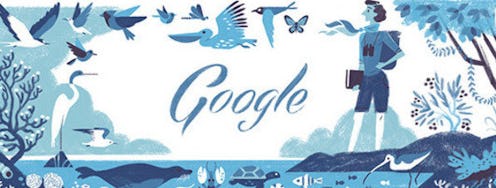News
Why Today's Google Doodle Is So Important

If Rachel Louise Carson's name doesn't ring a bell, today is a good day to get to know her. May 27 would be Carson's 107th birthday, and today's Google Doodle calls much-deserved attention to the profound work she completed during her life. Carson is best known today for her book Silent Spring, which lit an environmental movement around the globe in 1962. The harmful effects of pesticides on the human body and our environment was brought to the main global stage by Carson through her book, and she testified before Congress in 1963 against the use of pesticides.
Born in 1907 in Pennsylvania, Carson was concerned about the environment, and her first story was published at the young age of 11 in St. Nicholas magazine. Carson went on to earn a Master's Degree in Zoology from John Hopkins University in Maryland in 1932. Even before and following her college graduation, Carson worked at the Woods Hole Marine Biological Laboratory. She also wrote for the U.S Bureau of Fisheries, and was a scientist and an editor for 15 years with the federal government.
Carson had a great love for nature, evident in every piece of her writing. She penned three books about the sea, and she received a National Book Award for the first in the trilogy, The Sea Around Us. All three books, including Under the Sea Wind and The Edge of the Sea, were bestsellers.
Despite the fact that companies producing pesticides denied Carson's claims, one of the most harmful pesticides, known as DDT, was banned just 10 years later, and for good reason. DDT is a tasteless, colorless, and practically odorless pesticide that can greatly harm the human body. Since then, DDT has been banned around the globe.
Carson did not live without struggle. In 1957, her niece died, and so Carson adopted her niece's son. Then, in 1960, Carson was diagnosed with breast cancer. Carson had a lasting effect on environmental efforts and lived what many would call a full life, despite the fact that she died when she was 56 years old of a heart attack.
In 1980, President Jimmy Carter posthumously honored Carson with the Presidential Medal of Freedom. The U.S. Environmental Protection Agency was also created with Carson in mind.
On the 50th Anniversary of the publication of Silent Spring, environmental activist and writer Margaret Atwood wrote for The Guardian about Carson's greatest work:
Its subject was the human poisoning of the biosphere through the wholesale deployment of a myriad new 20th-century chemicals aimed at pest and disease control. Carson was already the most respected nature writer in the United States, and a pioneer in that field. She knew how to explain science to ordinary readers in a way that they could understand; she knew also that if you don't love a thing you won't save it, and her love for the natural world shines through everything she wrote. For Silent Spring — which she already knew would be her last tilt at the windmill — she polished all her rhetorical weapons, and synthesized a wide range of research. She was able to combine a simple and dramatic presentation with a formidable array of backup statistics, and to forge a call to specific action. The impact was enormous — many groups, pieces of legislation, and government agencies were inspired by it — and both its main insights remain central today.
Today, Carson's legacy lives on around the world. In Maryland, Carson's home where she penned Silent Spring still stands, and there is a conservation park and trail named there in her honor.
Image: Google